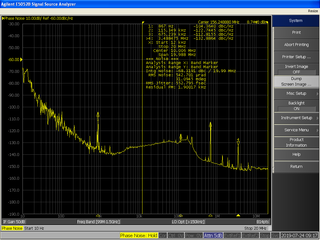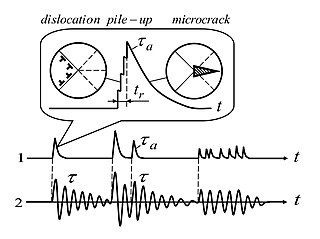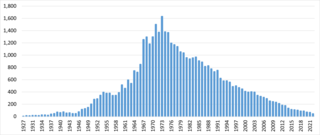Related Research Articles

Signal processing is an electrical engineering subfield that focuses on analyzing, modifying and synthesizing signals, such as sound, images, potential fields, seismic signals, altimetry processing, and scientific measurements. Signal processing techniques are used to optimize transmissions, digital storage efficiency, correcting distorted signals, subjective video quality, and to also detect or pinpoint components of interest in a measured signal.

In signal processing, phase noise is the frequency-domain representation of random fluctuations in the phase of a waveform, corresponding to time-domain deviations from perfect periodicity (jitter). Generally speaking, radio-frequency engineers speak of the phase noise of an oscillator, whereas digital-system engineers work with the jitter of a clock.

Pink noise, 1⁄f noise, fractional noise or fractal noise is a signal or process with a frequency spectrum such that the power spectral density is inversely proportional to the frequency of the signal. In pink noise, each octave interval carries an equal amount of noise energy.

A spectrum analyzer measures the magnitude of an input signal versus frequency within the full frequency range of the instrument. The primary use is to measure the power of the spectrum of known and unknown signals. The input signal that most common spectrum analyzers measure is electrical; however, spectral compositions of other signals, such as acoustic pressure waves and optical light waves, can be considered through the use of an appropriate transducer. Spectrum analyzers for other types of signals also exist, such as optical spectrum analyzers which use direct optical techniques such as a monochromator to make measurements.
In electrical engineering, partial discharge (PD) is a localized dielectric breakdown (DB) of a small portion of a solid or fluid electrical insulation (EI) system under high voltage (HV) stress. While a corona discharge (CD) is usually revealed by a relatively steady glow or brush discharge (BD) in air, partial discharges within solid insulation system are not visible.
Stochastic resonance (SR) is a phenomenon in which a signal that is normally too weak to be detected by a sensor can be boosted by adding white noise to the signal, which contains a wide spectrum of frequencies. The frequencies in the white noise corresponding to the original signal's frequencies will resonate with each other, amplifying the original signal while not amplifying the rest of the white noise – thereby increasing the signal-to-noise ratio, which makes the original signal more prominent. Further, the added white noise can be enough to be detectable by the sensor, which can then filter it out to effectively detect the original, previously undetectable signal.

In electrochemistry, cyclic voltammetry (CV) is a type of potentiodynamic measurement. In a cyclic voltammetry experiment, the working electrode potential is ramped linearly versus time. Unlike in linear sweep voltammetry, after the set potential is reached in a CV experiment, the working electrode's potential is ramped in the opposite direction to return to the initial potential. These cycles of ramps in potential may be repeated as many times as needed. The current at the working electrode is plotted versus the applied voltage to give the cyclic voltammogram trace. Cyclic voltammetry is generally used to study the electrochemical properties of an analyte in solution or of a molecule that is adsorbed onto the electrode.

Dielectric spectroscopy measures the dielectric properties of a medium as a function of frequency. It is based on the interaction of an external field with the electric dipole moment of the sample, often expressed by permittivity.

Acoustic emission (AE) is the phenomenon of radiation of acoustic (elastic) waves in solids that occurs when a material undergoes irreversible changes in its internal structure, for example as a result of crack formation or plastic deformation due to aging, temperature gradients, or external mechanical forces.

In radio reception, radio noise is unwanted random radio frequency electrical signals, fluctuating voltages, always present in a radio receiver in addition to the desired radio signal. Radio noise near in frequency to the radio signal being received interferes with it in the receiver's circuits. Radio noise is a combination of natural electromagnetic atmospheric noise created by electrical processes in the atmosphere like lightning, manmade radio frequency interference (RFI) from other electrical devices picked up by the receiver's antenna, and thermal noise present in the receiver input circuits, caused by the random thermal motion of molecules.

Polarography is a type of voltammetry where the working electrode is a dropping mercury electrode (DME) or a static mercury drop electrode (SMDE), which are useful for their wide cathodic ranges and renewable surfaces. It was invented in 1922 by Czechoslovak chemist Jaroslav Heyrovský, for which he won the Nobel prize in 1959. The main advantages of mercury as electrode material are as follows: 1) a large voltage window: ca. from +0.2 V to -1.8 V vs reversible hydrogen electrode (RHE). Hg electrode is particularly well-suited for studying electroreduction reactions. 2) very reproducible electrode surface, since mercury is liquid. 3) very easy cleaning of the electrode surface by making a new drop of mercury from a large Hg pool connected by a glass capillary.

In electronics, noise is an unwanted disturbance in an electrical signal.
Audio noise measurement is a process carried out to assess the quality of audio equipment, such as the kind used in recording studios, broadcast engineering, and in-home high fidelity.
Laser absorption spectrometry (LAS) refers to techniques that use lasers to assess the concentration or amount of a species in gas phase by absorption spectrometry (AS).
Concrete electrical resistivity can be obtained by applying a current into the concrete and measuring the response voltage. There are different methods for measuring concrete resistivity.
Sensing of phage-triggered ion cascades (SEPTIC) is a prompt bacterium identification method based on fluctuation-enhanced sensing in fluid medium. The advantages of SEPTIC are the specificity and speed offered by the characteristics of phage infection, the sensitivity due to fluctuation-enhanced sensing, and durability originating from the robustness of phages. An idealistic SEPTIC device may be as small as a pen and maybe able to identify a library of different bacteria within a few minutes measurement window.
Noise-based logic (NBL) is a class of multivalued deterministic logic schemes, developed in the twenty-first century, where the logic values and bits are represented by different realizations of a stochastic process. The concept of noise-based logic and its name was created by Laszlo B. Kish. In its foundation paper it is noted that the idea was inspired by the stochasticity of brain signals and by the unconventional noise-based communication schemes, such as the Kish cypher.
Noise refers to many types of random, troublesome, problematic, or unwanted signals.

Switching Noise Jitter (SNJ) is the aggregation of variability of noise events in the time-domain on the supply bias of an electronic system, in particular with a voltage regulated supply bias incorporated with closed-loop (feedback) control, for instance, SMPS. SNJ is measurable using real-time spectral histogram analysis and expressed as a rate of occurrence in percentage. The existence of SNJ was firstly demonstrated and termed by TransSiP Inc in 2016 and 2017 at the Applied Power Electronics Conference (APEC), and reviewed with experts at Tektronix prior to be featured as a case study published by Tektronix. The discovery of SNJ was also featured in multiple articles published by Planet Analog magazine and EDN Network. Difficult to filter using conventional LC networks due to variability in both time and frequency domains, SNJ can introduce random errors in analog to digital conversion, affecting both data integrity and system performance in digital communications and location-based services
Scanning vibrating electrode technique (SVET), also known as vibrating probe within the field of biology, is a scanning probe microscopy (SPM) technique which visualizes electrochemical processes at a sample. It was originally introduced in 1974 by Jaffe and Nuccitelli to investigate the electrical current densities near living cells. Starting in the 1980s Hugh Isaacs began to apply SVET to a number of different corrosion studies. SVET measures local current density distributions in the solution above the sample of interest, to map electrochemical processes in situ as they occur. It utilizes a probe, vibrating perpendicular to the sample of interest, to enhance the measured signal. It is related to scanning ion-selective electrode technique (SIET), which can be used with SVET in corrosion studies, and scanning reference electrode technique (SRET), which is a precursor to SVET.
References
- Cottis, R.A. (1996), "The effects of solution resistance on electrochemical noise resistance measurements:A theoretical analysis", in Jeffery R, Kearns; John R, Scully (eds.), Electrochemical Noise Measurement for Corrosion Applications, Special Testing Publications, vol. 1277, ASTM International, ISBN 978-0-8031-2032-7
- Dawson, J.L. (1996), "Electrochemical Noise Measurements", in Jeffery R, Kearns; John R, Scully (eds.), Electrochemical Noise Measurement for Corrosion Applications, Special Testing Publications, vol. 1277, ASTM International, ISBN 978-0-8031-2032-7
- Mansfield, F; Xiao, H (1996), "Electrochemical Noise and Impedance Analysis of Iron in Chloride Media", in Jeffery R, Kearns; John R, Scully (eds.), Electrochemical Noise Measurement for Corrosion Applications, Special Testing Publications, vol. 1277, ASTM International, ISBN 978-0-8031-2032-7
- "Guide for Electrochemical Noise Measurement". 2009. doi:10.1520/G0199-09.
{{cite journal}}: Cite journal requires|journal=(help) - Tan, Y. (2011). "Experimental methods designed for measuring corrosion in highly resistive and inhomogeneous media". Corrosion Science. 53 (4): 1145–1155. doi:10.1016/j.corsci.2011.01.018.